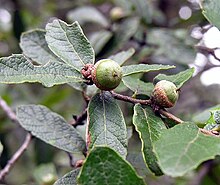Quercus castanea
| Quercus castanea | |
|---|---|

| |
| Scientific classification | |
| Kingdom: | Plantae |
| Clade: | Tracheophytes |
| Clade: | Angiosperms |
| Clade: | Eudicots |
| Clade: | Rosids |
| Order: | Fagales |
| Family: | Fagaceae |
| Genus: | Quercus |
| Subgenus: | Quercus subg. Quercus |
| Section: | Quercus sect. Lobatae |
| Species: | Q. castanea
|
| Binomial name | |
| Quercus castanea | |
| Synonyms[2] | |
|
List
| |
Quercus castanea is a species of oak tree. It is widespread across much of Mexico, from Sonora to Chiapas, and in Central America.
Description
[edit]It is a deciduous tree up to 15 metres (49 feet) tall with a trunk as much as 80 cm (31 in) in diameter. The leaves are thick and leathery, up to 11.6 cm (4+1⁄2 in) long, and elliptical with numerous pointed teeth along the edges.[3] It flowers from March to June, and its acorns mature between October and December.[1]
The species hybridizes with other sympatric red oak species across its range.[1]
Distribution and habitat
[edit]Quercus castanea is native to the mountains of Mexico, Guatemala, El Salvador, and Honduras.[3][4][1] In Mexico, the species inhabits the Sierra Madre Oriental, Sierra Madre Occidental, Trans-Mexican Volcanic Belt, Sierra Madre de Oaxaca, and Sierra Madre del Sur between 1,400 and 2,600 m (4,600 and 8,500 ft) elevation. It also inhabits the Sierra Madre de Chiapas of Mexico Mexico and Guatemala, and the Montecristo Massif where the borders of El Salvador, Guatemala, and Honduras meet. In Guatemala, Q. castanea has been reported up to 3,500 m (11,500 ft) elevation. The species' estimated extent of occurrence is 1,110,000 square kilometres (430,000 sq mi), based on over 500 collections and herbarium records.[1]
The species is found in a variety of montane habitats. It is common in dry oak forests, xerophytic shrublands, and open oak woodlands alongside cacti and trees of family Leguminaceae. It also grows in humid montane cloud forests.[1]
In the Cuitzeo Basin of central Mexico, acorn woodpeckers (Melanerpes formicivorus) and golden-fronted woodpeckers (Melanerpes aurifrons) are important acorn dispersers.[1]
References
[edit]- ^ a b c d e f g Wenzell, K. & Kenny, L. 2015. Quercus castanea. The IUCN Red List of Threatened Species 2015: e.T194073A2296266. https://dx.doi.org/10.2305/IUCN.UK.2015-4.RLTS.T194073A2296266.en. Accessed 1 October 2022.
- ^ "Quercus castanea Née". World Checklist of Selected Plant Families. Royal Botanic Gardens, Kew – via The Plant List. Note that this website has been superseded by World Flora Online
- ^ a b Romero Rangel, S., E. C. Rojas Zenteno & M. L. Aguilar Enríquez. 2002. El género Quercus (Fagaceae) en el estado de México. Annals of the Missouri Botanical Garden 89(4): 551–593 in Spanish, with line drawings of each species
- ^ McVaugh, R. 1974. Flora Novo-Galiciana: Fagaceae. Contributions from the University of Michigan Herbarium 12(1,3): 1–93
External links
[edit]- IUCN Red List least concern species
- Quercus
- Oaks of Mexico
- Flora of the Sierra Madre Occidental
- Flora of the Sierra Madre Oriental
- Flora of the Trans-Mexican Volcanic Belt
- Flora of the Sierra Madre de Oaxaca
- Flora of the Sierra Madre del Sur
- Flora of the Central American montane forests
- Sierra Madre de Chiapas
- Flora of the Chiapas Highlands
- Trees of Northern America
- Trees of Guatemala
- Trees of El Salvador
- Trees of Honduras
- Plants described in 1801

